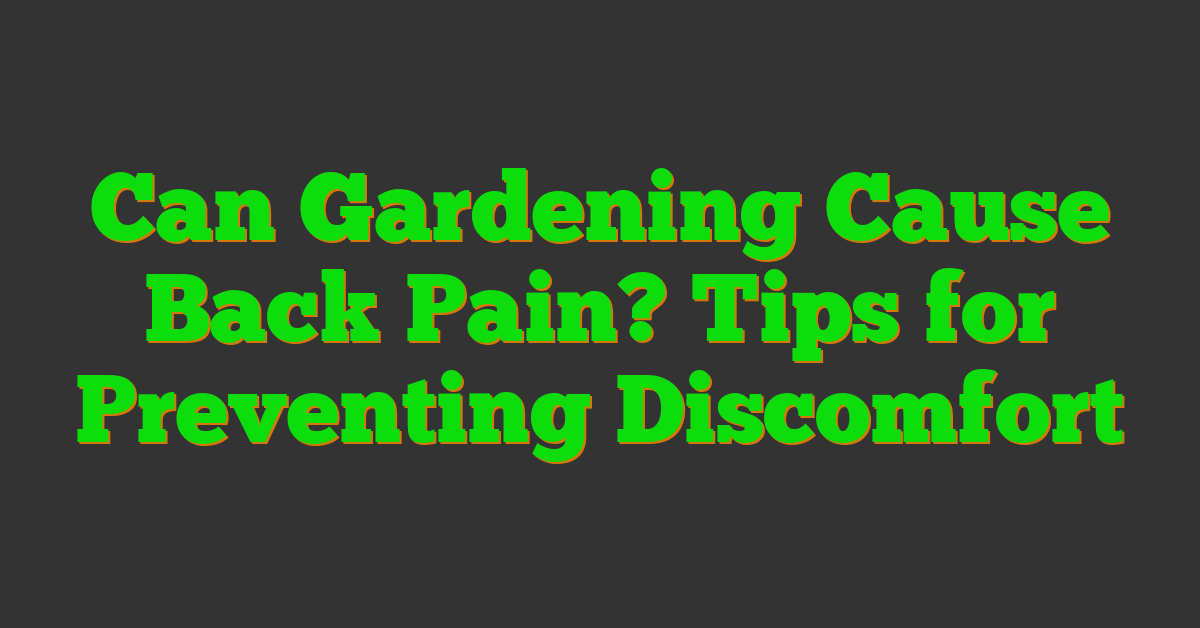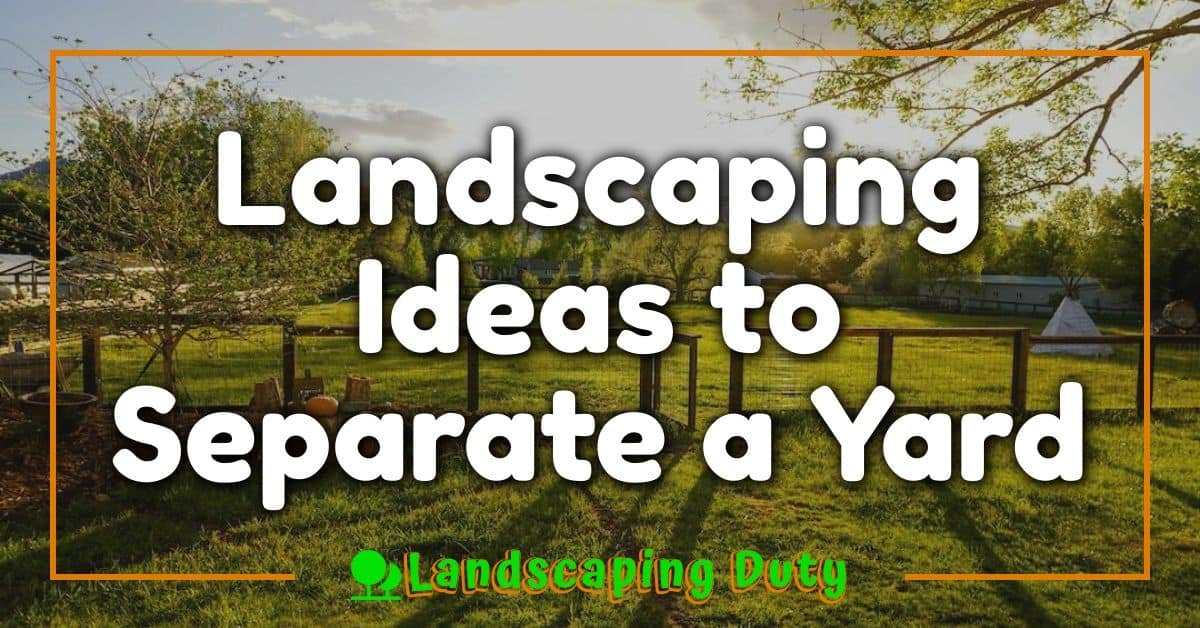Gardening is a favorite pastime for many people. It is a great way to get some fresh air, spend time in nature, and grow your own fruits and vegetables. However, gardening can also cause back pain, especially if you are not careful. In this article, we will explore whether gardening can cause back pain and what you can do to prevent it.

Back pain is a common problem for gardeners. It can be caused by a variety of factors, such as bending, lifting, and twisting. The repetitive motions involved in gardening can also put a strain on your back muscles and joints. If you are not careful, you could end up with a sore back that makes it difficult to enjoy your garden. So, can gardening cause back pain? The answer is yes, but there are steps you can take to prevent it.
Key Takeaways
- Gardening can cause back pain due to repetitive motions and strain on back muscles and joints.
- Preventive measures such as warming up, using proper tools, and taking breaks can help avoid back pain while gardening.
- Gardening can provide many health and wellness benefits, so taking steps to prevent back pain can help you enjoy this hobby for years to come.
Understanding Back Pain in Gardening

https://www.youtube.com/watch?v=LqIQKjjZOb0&embed=true
Gardening is a great way to get outside, enjoy the fresh air, and get some exercise. However, it can also be hard on your back. Back pain is a common complaint among gardeners, and it can be caused by a variety of factors.
Common Causes of Back Pain in Gardeners
One of the most common causes of back pain in gardeners is poor posture. When you are working in the garden, it is important to maintain good posture to avoid putting unnecessary strain on your back. This means keeping your back straight and your shoulders back, and avoiding bending or twisting at the waist.
Another common cause of back pain in gardeners is overuse. When you spend hours in the garden, you may be using the same muscles over and over again, which can lead to muscle fatigue and pain. To avoid this, it is important to take frequent breaks and stretch your muscles regularly.
Anatomy of the Back: Muscles and Joints Involved
To understand back pain in gardening, it is important to understand the anatomy of the back. The back is made up of a complex network of muscles, bones, and joints that work together to support the body and allow for movement.
The muscles of the back are responsible for supporting the spine and allowing for movement in the shoulders, neck, and hips. The spinal column is made up of 24 vertebrae, which are separated by intervertebral discs that act as shock absorbers. The joints of the back are also important for movement and stability, and they can become inflamed or injured with overuse or poor posture.
When gardening, it is important to be mindful of your posture and to take breaks to avoid overuse of the muscles and joints in your back. By taking these simple steps, you can enjoy gardening without experiencing chronic back pain.
Preventive Measures for Gardeners
https://www.youtube.com/watch?v=z_t3FvABTtE&embed=true
Gardening is a fun and rewarding activity, but it can also be physically demanding and cause back pain. However, there are several preventive measures you can take to avoid back pain while gardening. Here are some tips:
Proper Gardening Posture
Maintaining proper posture is essential to prevent back pain while gardening. Here are some tips to help you maintain proper posture:
- Keep your back straight and avoid bending forward for long periods.
- Bend your knees and use your legs to lift heavy objects instead of your back.
- Avoid twisting your back while lifting or digging. Instead, move your feet to face the direction you need to work in.
- Take frequent breaks to stretch and rest your back.
Warm-Up and Stretching Exercises
Before you start gardening, it’s important to warm up your muscles and stretch to prevent injury. Here are some warm-up and stretching exercises you can do:
- Take a brisk walk or jog for a few minutes to warm up your muscles.
- Stretch your back, legs, and arms by doing exercises such as toe touches, lunges, and arm circles.
- Hold each stretch for 15-30 seconds and repeat 2-3 times.
Using Ergonomic Gardening Tools
Using ergonomic gardening tools can help reduce the strain on your back and prevent pain. Here are some ergonomic tools you can use:
- Use a knee pad or cushion to protect your knees while kneeling or sitting.
- Use a long-handled tool to avoid bending over or reaching too far.
- Use a lightweight garden cart or wheelbarrow to transport heavy objects instead of carrying them.
By following these preventive measures, you can enjoy gardening without worrying about back pain. Remember to take breaks, stretch, and use ergonomic tools to make gardening easier and more comfortable.
Gardening Techniques to Avoid Back Pain
https://www.youtube.com/watch?v=vLehDRWhhF4&embed=true
Gardening is a great way to enjoy the outdoors and get some exercise. However, it can also cause back pain if you are not careful. By using proper techniques and tools, you can reduce your risk of injury and enjoy gardening without pain.
Safe Lifting and Bending Techniques
Lifting and bending are common movements in gardening, but they can also be the cause of back pain. To avoid injury, follow these safe lifting and bending techniques:
- Lift with your legs, not your back: When lifting heavy objects, such as bags of soil or pots, bend your knees and keep your back straight. Use the strength in your legs to lift the object, rather than your back.
- Avoid twisting: When lifting, avoid twisting your back. Instead, pivot your feet to turn your body.
- Use a shovel: When digging, use a shovel to avoid bending over too much. Use your legs to push the shovel into the ground, and keep your back straight.
- Take breaks: Take frequent breaks to rest your back and stretch your muscles.
Alternatives to Bending and Kneeling
Bending and kneeling can put a lot of strain on your back and knees. Try these alternatives to reduce your risk of injury:
- Use raised beds: Raised beds can be a great option if you have trouble bending or kneeling. They allow you to garden at a comfortable height without putting strain on your back and knees.
- Sit on a stool: Use a stool or chair to sit on while gardening. This can reduce the amount of time you spend bending and kneeling.
- Use long-handled tools: Use long-handled tools to reach plants and weeds without bending over.
Strategic Gardening Layout and Planning
The layout of your garden can also affect your risk of back pain. Here are some tips for strategic gardening layout and planning:
- Group plants together: Group plants together based on their watering and maintenance needs. This can reduce the amount of time you spend walking back and forth, which can put strain on your back.
- Use a lawnmower: Use a lawnmower to cut the grass instead of a push mower. This can reduce the amount of time you spend bending over.
- Minimize reaching: Plant taller plants in the back of the garden so you don’t have to reach over shorter plants to tend to them.
- Take it slow: Don’t try to do too much at once. Pace yourself and take breaks as needed.
By following these gardening techniques, you can reduce your risk of back pain and enjoy gardening without injury. Remember to listen to your body and stop if you feel any pain or discomfort.
Managing Existing Back Pain While Gardening
https://www.youtube.com/watch?v=HsN_V1uD0Ew&embed=true
« Is Landscape Fabric Bad for the Environment? Exploring the Environmental Impact of Landscape Fabric Are Landscaping Improvements Tax Deductible? A Quick Guide »
If you already suffer from back pain, you may think that gardening is off-limits. But with some modifications, you can still enjoy your time in the garden without exacerbating your pain. Here are some tips to help you manage existing back pain while gardening.
Gardening Modifications for Back Pain Relief
There are several modifications you can make to your gardening routine to help relieve back pain. Here are a few suggestions:
Use raised garden beds: Raised garden beds can help reduce the strain on your back by allowing you to garden at a more comfortable height. This can be especially helpful if you have chronic back pain or a back injury.
Take frequent breaks: Gardening can be physically demanding, so it’s important to take frequent breaks to rest your back. Try to take a break every 20-30 minutes to stretch and rest.
Use ergonomic tools: Ergonomic tools are designed to reduce the strain on your body while gardening. Look for tools with padded handles and long handles to help reduce the amount of bending and stooping required.
Use a gardening stool or kneeler: A gardening stool or kneeler can help reduce the strain on your back by allowing you to sit or kneel while you garden.
When to Seek Professional Help
If your back pain is severe or persists despite your best efforts to manage it, it may be time to seek professional help. A physical therapist can help you develop a personalized exercise and stretching program to help relieve your pain and prevent future injury.
In some cases, your back pain may be caused by inflammation or muscle spasms. Your doctor may recommend anti-inflammatory medications or muscle relaxants to help relieve your pain.
If you experience tingling, numbness, or muscle cramps in addition to your back pain, it’s important to seek medical attention right away. These symptoms could be a sign of a more serious underlying condition.
In addition to seeking professional help, you can also try using cold compresses or taking over-the-counter pain relievers like ibuprofen to help relieve your pain. Just be sure to follow the instructions on the label and talk to your doctor before taking any new medications.
Health and Wellness Benefits of Gardening
https://www.youtube.com/watch?v=t3osRE2ccrM&embed=true
Gardening is not just a way to beautify your surroundings or grow fresh vegetables and fruits. It also provides a wide range of health and wellness benefits that can improve your physical and mental well-being. In this section, we’ll explore some of the most significant benefits of gardening.
Physical Activity and Muscle Strengthening
Gardening is a form of physical activity that can help you stay fit and healthy. It involves a range of movements, such as digging, planting, weeding, and watering, that can provide a full-body workout. Regular gardening can help you build strength in your core muscles, arms, and legs, which can improve your balance and reduce the risk of falls.
Stress Reduction and Mental Health
Spending time in nature and working with plants can have a calming effect on the mind and body. Gardening can help reduce stress, anxiety, and depression, and improve your overall sense of well-being. It can also provide a sense of accomplishment and boost your self-esteem.
In addition to these benefits, gardening can also help you eat healthier by providing fresh vegetables and fruits. It can also be a fun and rewarding activity that you can enjoy with friends and family. To get the most out of gardening, it’s important to practice proper techniques and use ergonomic tools to prevent injuries. Stretching exercises and yoga can also help you stay limber and prevent back pain.
Practical Tips for Sustainable Gardening

Gardening is an enjoyable activity that can provide many health benefits. However, it can also lead to back pain if not done properly. In this section, we will provide practical tips to help you garden sustainably without causing back pain.
Incorporating Breaks and Body Awareness
One of the most important things you can do to prevent back pain while gardening is to take frequent breaks. Stand up, walk around, and stretch your back and legs every 20-30 minutes. This will help prevent muscle fatigue and strain. Additionally, it is important to be aware of your body position while gardening. Avoid leaning forward or bending over for extended periods of time, as this can put stress on your back muscles. Instead, try squatting or kneeling to work at ground level.
Gardening Equipment and Assistive Devices
Using the right gardening equipment and assistive devices can also help prevent back pain. Consider using a wheelbarrow to move heavy bags of mulch or soil instead of lifting them. When lifting, use proper techniques such as bending your knees and keeping your back straight. You can also use kneelers or quadruped devices to reduce stress on your back while working at ground level. Additionally, using ergonomic gardening tools can help reduce strain on your hands and wrists.
In summary, by incorporating breaks, body awareness, and using the right gardening equipment and assistive devices, you can garden sustainably without causing back pain. Remember to take care of your body while doing yard work and use proper lifting techniques to prevent injuries.
Frequently Asked Questions
https://www.youtube.com/watch?v=zLfwwY6K3U0&embed=true
What are the best practices to avoid back pain while gardening?
Gardening is a fun and rewarding activity, but it can also be physically demanding and cause back pain. To avoid back pain while gardening, it is important to follow some best practices such as maintaining proper posture, taking frequent breaks, and using ergonomic tools. Make sure to warm up before starting any gardening tasks and stretch your muscles regularly to avoid stiffness and soreness.
Can lifting heavy objects in the garden lead to lower back pain?
Yes, lifting heavy objects in the garden can lead to lower back pain. It is important to lift with your legs and not your back to avoid straining your muscles. Use a wheelbarrow or cart to transport heavy items and avoid carrying them for long distances. If you must lift something heavy, ask for help or use a lifting aid.
How can I manage buttock pain after a day of gardening?
Buttock pain after gardening can be managed by stretching your glutes and hamstrings regularly. Try doing some gentle yoga poses or stretches to alleviate the pain. You can also apply heat or ice to the affected area to reduce inflammation and soothe sore muscles.
What are some effective ways to weed my garden if I have a bad back?
If you have a bad back, it is important to avoid bending or squatting for long periods of time. You can use a kneeling pad or garden stool to reduce the strain on your back while weeding. Consider using long-handled tools to reach weeds without bending over. You can also use mulch or ground cover to reduce the amount of weeding needed.
Are there any specific exercises to strengthen my back for gardening tasks?
Yes, there are several exercises that can help strengthen your back for gardening tasks. Try doing some back extensions, planks, or bird dogs to strengthen your core and back muscles. Yoga and Pilates can also be helpful for improving flexibility and strengthening your muscles.
Does gardening contribute to abdominal pain, and how can it be alleviated?
Gardening can contribute to abdominal pain if you are using your core muscles to lift heavy objects or perform repetitive tasks. To alleviate abdominal pain, make sure to engage your core muscles properly and avoid overexerting yourself. Take frequent breaks and stretch your muscles regularly to avoid stiffness and soreness.










